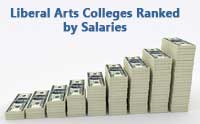 Finally! This is the longest I’ve waited to update my list of 50-50 Colleges. For reasons unknown, the Integrated Postsecondary Education System (IPEDS) only recently released the updated graduation rates although they have been showing up on College Navigator for some time now. I try not to take it personally. So while I’m not quite yet finished updating the DIY College Search Spreadsheet, I have generated the new listing of 50-50 Colleges.
Finally! This is the longest I’ve waited to update my list of 50-50 Colleges. For reasons unknown, the Integrated Postsecondary Education System (IPEDS) only recently released the updated graduation rates although they have been showing up on College Navigator for some time now. I try not to take it personally. So while I’m not quite yet finished updating the DIY College Search Spreadsheet, I have generated the new listing of 50-50 Colleges.
50-50 College Highlights
50-50 Highlights: Liberal Arts Colleges Ranked by Median Earnings
 Evaluating Liberal Arts Colleges by how much graduates make is antithetical to the concept of a liberal arts education in so many ways. But given the fact that 100 Liberal Arts Colleges now cost more than $50,000, I don’t care how much aid the students are receiving, families have every right to know what kind of pay-off the student can expect. This doesn’t mean that families don’t appreciate the value of a liberal arts education. It’s just recognition that there will bills and loans to repay after graduation.
Evaluating Liberal Arts Colleges by how much graduates make is antithetical to the concept of a liberal arts education in so many ways. But given the fact that 100 Liberal Arts Colleges now cost more than $50,000, I don’t care how much aid the students are receiving, families have every right to know what kind of pay-off the student can expect. This doesn’t mean that families don’t appreciate the value of a liberal arts education. It’s just recognition that there will bills and loans to repay after graduation.
50-50 Highlights: Doctoral/Research Universities Ranked by Students’ Salaries
 This fall’s college rankings have made earnings and return on investment a more prominent consideration when selecting a college. And with the ever increasing cost of college, this is a very reasonable reaction. However, ranking colleges by some form of graduates’ salaries has its own set of problems. Teachers simply don’t make as much as engineers or investment bankers but we need teachers. Incomes are higher in areas with higher costs of living. And these are just some of the obvious issues of ranking universities by graduates’ salaries. But this shouldn’t stop you from using the available information–just understand its limitations.
This fall’s college rankings have made earnings and return on investment a more prominent consideration when selecting a college. And with the ever increasing cost of college, this is a very reasonable reaction. However, ranking colleges by some form of graduates’ salaries has its own set of problems. Teachers simply don’t make as much as engineers or investment bankers but we need teachers. Incomes are higher in areas with higher costs of living. And these are just some of the obvious issues of ranking universities by graduates’ salaries. But this shouldn’t stop you from using the available information–just understand its limitations.
5 Most Popular Free Downloads to Help You Find a College
 I know that not everyone is able to keep up with all of the information I post to the website. For the past six months or so I’ve been creating PDFs for some of the posts, usually those with lists of colleges but not always. In case you’ve missed them, I’m listing the five most popular posts based on their PDF downloads. And no, there isn’t any fee for downloading.
I know that not everyone is able to keep up with all of the information I post to the website. For the past six months or so I’ve been creating PDFs for some of the posts, usually those with lists of colleges but not always. In case you’ve missed them, I’m listing the five most popular posts based on their PDF downloads. And no, there isn’t any fee for downloading.
50-50 Highlights: Is Your College Degree Worth More Than a High School Diploma?
 Something happened this weekend that most families trying to figure out how to pick and pay for college missed–and most colleges are probably good with this. This weekend the government released a revised College Scorecard that lets users filter schools based on graduation rates, average annual costs, and graduate median salary. Better yet, all the data collected (although not necessarily used) by the College Scorecard was also released for downloading. Guess what I’ve been doing since Sunday?
Something happened this weekend that most families trying to figure out how to pick and pay for college missed–and most colleges are probably good with this. This weekend the government released a revised College Scorecard that lets users filter schools based on graduation rates, average annual costs, and graduate median salary. Better yet, all the data collected (although not necessarily used) by the College Scorecard was also released for downloading. Guess what I’ve been doing since Sunday?
50-50 Highlights: Colleges in the Top 100 of PayScale College Salary Rankings
 Another week and another set of college rankings-must be back to school time. This week PayScale released its College Salary Report. As far as rankings go, it has several features to recommend it. The primary advantage is that it really is exclusively focused on outcomes. No national reputation score, no attempts to measure the qualities of the students. It’s strictly based on income of graduates.
Another week and another set of college rankings-must be back to school time. This week PayScale released its College Salary Report. As far as rankings go, it has several features to recommend it. The primary advantage is that it really is exclusively focused on outcomes. No national reputation score, no attempts to measure the qualities of the students. It’s strictly based on income of graduates.
50-50 Highlights: 28 Colleges with the Best ROI That You Can Actually Get Into
 Money’s Best Colleges is one of the increasing alternatives to US News Best College Rankings. According to Washington Post, “Money Magazine’s new college rankings finally get it right for students” since it focuses on the cost to the student and likely return on investment. I’m not willing to declare Money’s College Rankings as the way rankings should be done, but I will acknowledge that it’s a step in the right direction.
Money’s Best Colleges is one of the increasing alternatives to US News Best College Rankings. According to Washington Post, “Money Magazine’s new college rankings finally get it right for students” since it focuses on the cost to the student and likely return on investment. I’m not willing to declare Money’s College Rankings as the way rankings should be done, but I will acknowledge that it’s a step in the right direction.
50-50 Highlights: Colleges for Non-traditional Students
 In case you haven’t heard, most college students aren’t the traditional 18-year-olds, starting college full-time the fall after they graduate from high school. That’s because the term college students include both part-time and full-time as well as those attending community colleges, for-profit schools, and school that don’t offer degrees.
In case you haven’t heard, most college students aren’t the traditional 18-year-olds, starting college full-time the fall after they graduate from high school. That’s because the term college students include both part-time and full-time as well as those attending community colleges, for-profit schools, and school that don’t offer degrees.
50-50 Highlights: Availability/Attendance of Colleges with High Graduation Rates by State
 Perhaps you’ve seen some variation of this headline recently: “Most colleges students don’t graduate on time.” And maybe you’ve thought, “What’s the deal with college students these days?” and just left it at that. But what if the headline was “Most colleges fail to graduate students in 4 years?” Who are you thinking about now, the college or the student?
Perhaps you’ve seen some variation of this headline recently: “Most colleges students don’t graduate on time.” And maybe you’ve thought, “What’s the deal with college students these days?” and just left it at that. But what if the headline was “Most colleges fail to graduate students in 4 years?” Who are you thinking about now, the college or the student?
